BSBRSK501 Project: One Pharmacy's Risk Management Evaluation
VerifiedAdded on 2023/06/15
|12
|2195
|312
Report
AI Summary
This report assesses the effectiveness of One Pharmacy's risk management framework, aligning it with AS/NZS ISO 31000:2009 standards. It identifies the scope of risk management, critical success factors, goals, objectives, and stakeholders. The report outlines the roles of internal stakeholders like ...
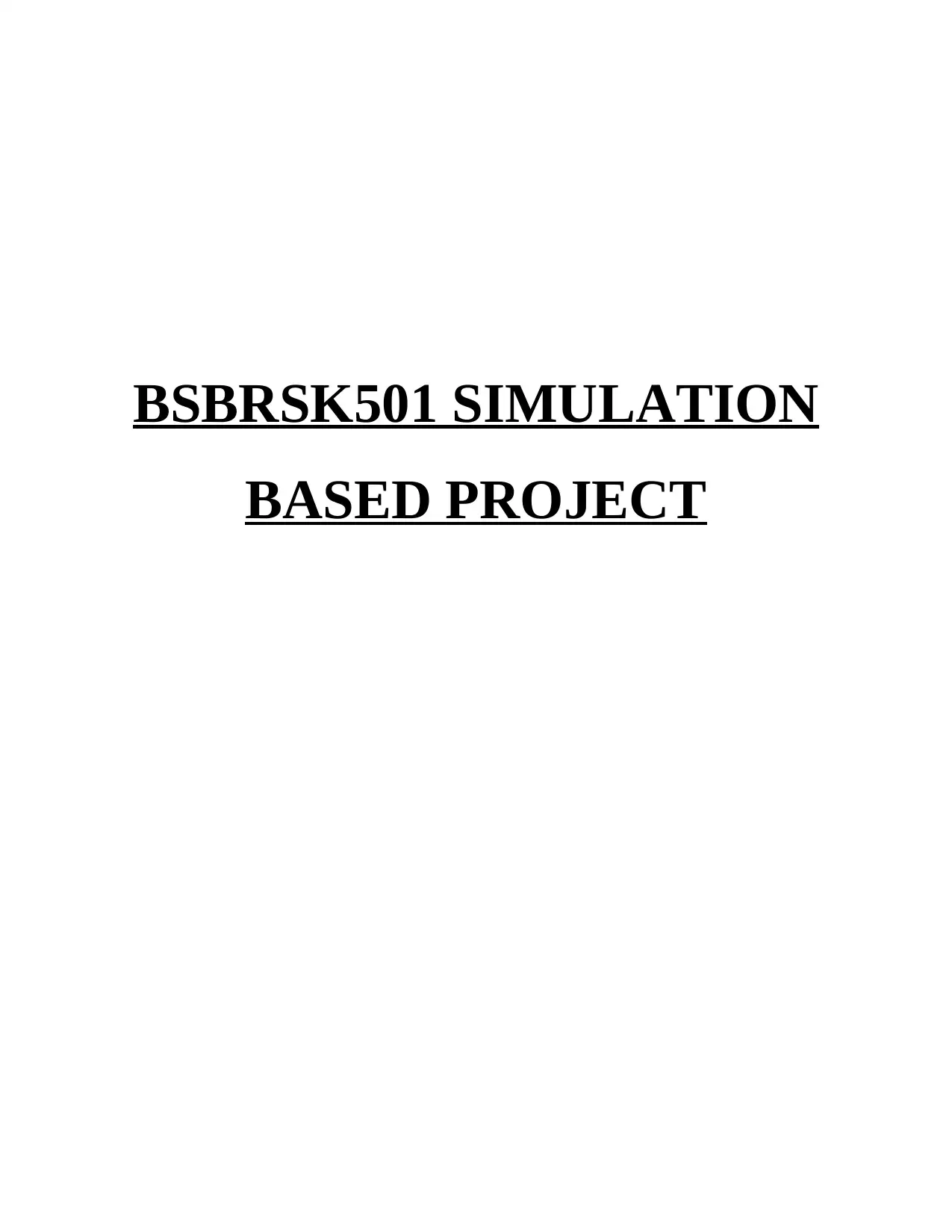
BSBRSK501 SIMULATION
BASED PROJECT
BASED PROJECT
Paraphrase This Document
Need a fresh take? Get an instant paraphrase of this document with our AI Paraphraser
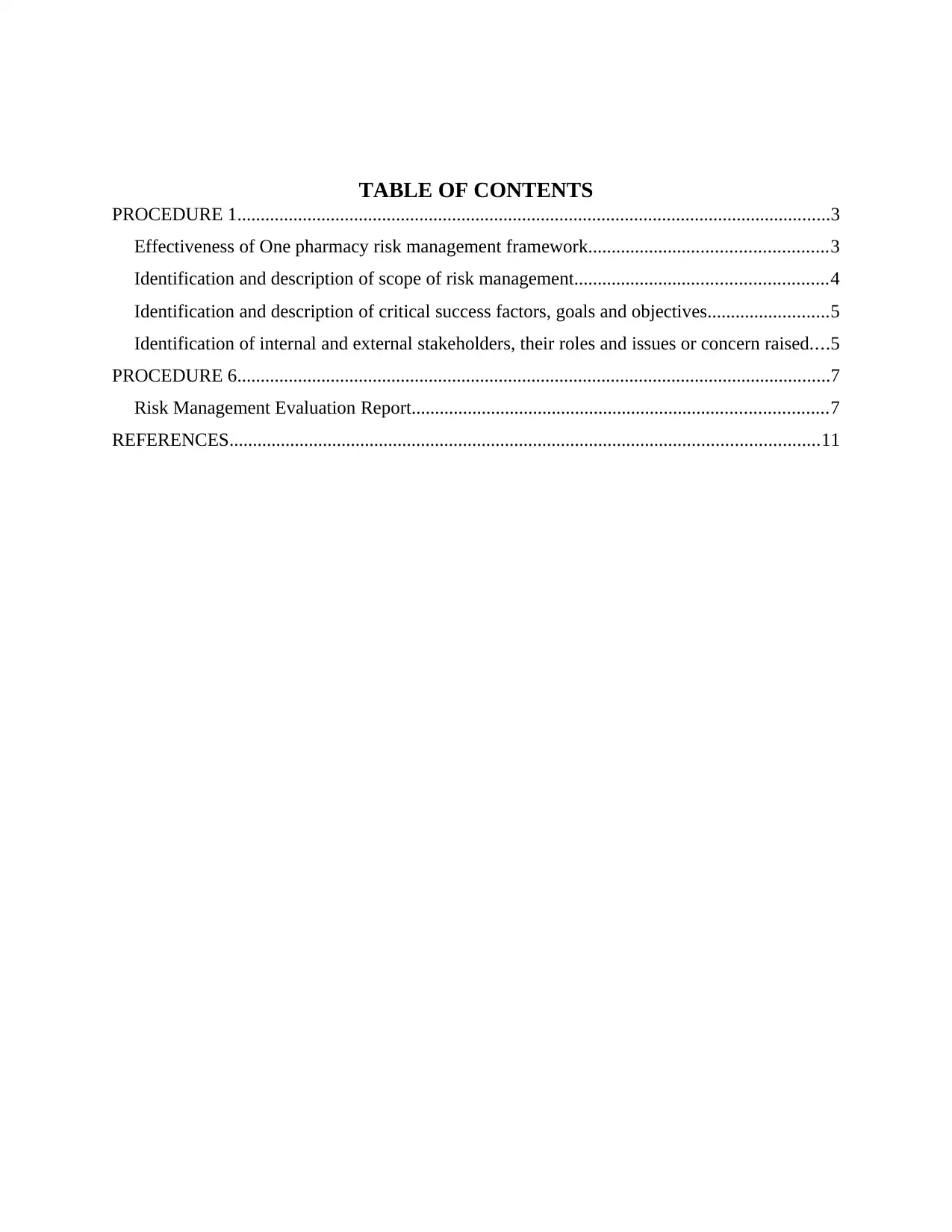
TABLE OF CONTENTS
PROCEDURE 1...............................................................................................................................3
Effectiveness of One pharmacy risk management framework...................................................3
Identification and description of scope of risk management......................................................4
Identification and description of critical success factors, goals and objectives..........................5
Identification of internal and external stakeholders, their roles and issues or concern raised....5
PROCEDURE 6...............................................................................................................................7
Risk Management Evaluation Report.........................................................................................7
REFERENCES..............................................................................................................................11
PROCEDURE 1...............................................................................................................................3
Effectiveness of One pharmacy risk management framework...................................................3
Identification and description of scope of risk management......................................................4
Identification and description of critical success factors, goals and objectives..........................5
Identification of internal and external stakeholders, their roles and issues or concern raised....5
PROCEDURE 6...............................................................................................................................7
Risk Management Evaluation Report.........................................................................................7
REFERENCES..............................................................................................................................11
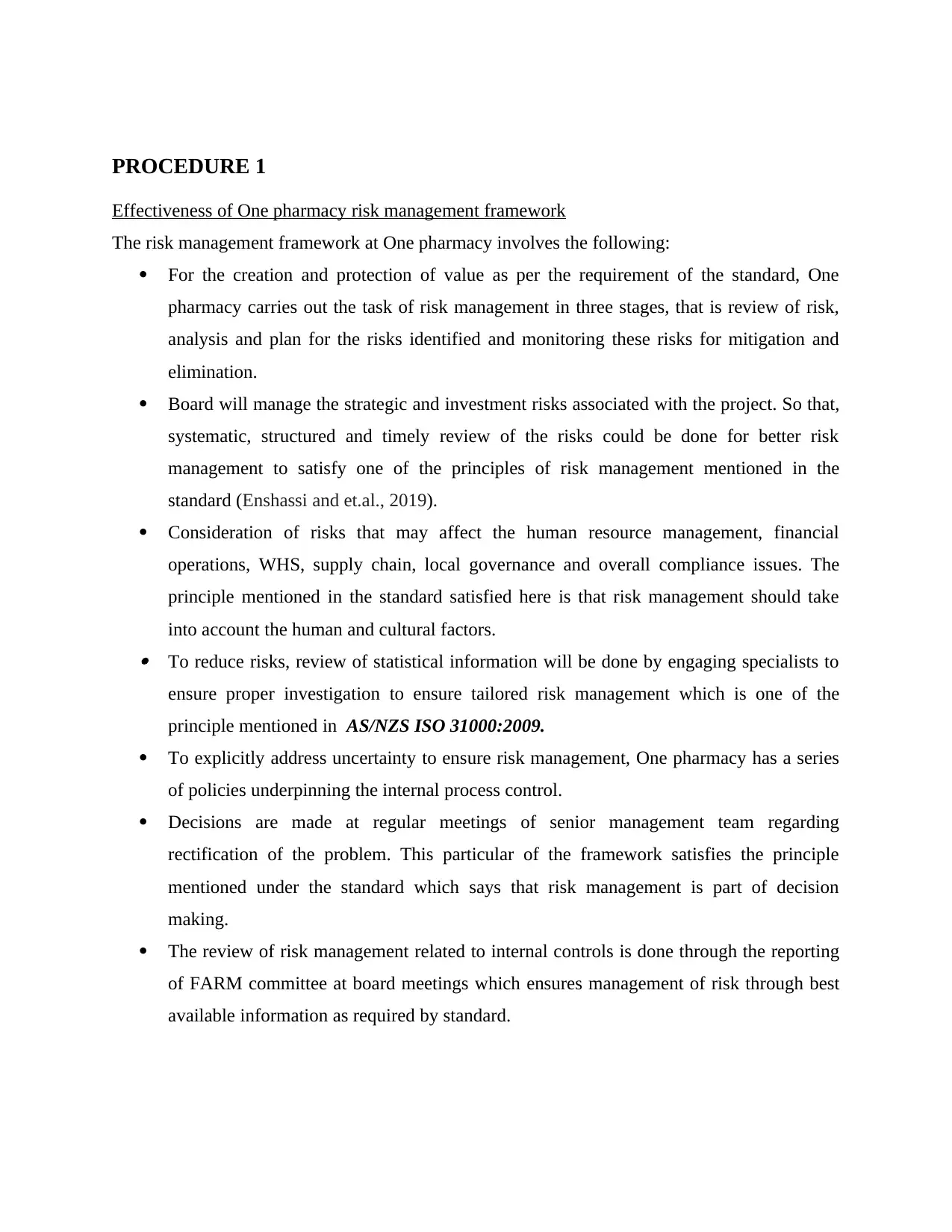
PROCEDURE 1
Effectiveness of One pharmacy risk management framework
The risk management framework at One pharmacy involves the following:
For the creation and protection of value as per the requirement of the standard, One
pharmacy carries out the task of risk management in three stages, that is review of risk,
analysis and plan for the risks identified and monitoring these risks for mitigation and
elimination.
Board will manage the strategic and investment risks associated with the project. So that,
systematic, structured and timely review of the risks could be done for better risk
management to satisfy one of the principles of risk management mentioned in the
standard (Enshassi and et.al., 2019).
Consideration of risks that may affect the human resource management, financial
operations, WHS, supply chain, local governance and overall compliance issues. The
principle mentioned in the standard satisfied here is that risk management should take
into account the human and cultural factors. To reduce risks, review of statistical information will be done by engaging specialists to
ensure proper investigation to ensure tailored risk management which is one of the
principle mentioned in AS/NZS ISO 31000:2009.
To explicitly address uncertainty to ensure risk management, One pharmacy has a series
of policies underpinning the internal process control.
Decisions are made at regular meetings of senior management team regarding
rectification of the problem. This particular of the framework satisfies the principle
mentioned under the standard which says that risk management is part of decision
making.
The review of risk management related to internal controls is done through the reporting
of FARM committee at board meetings which ensures management of risk through best
available information as required by standard.
Effectiveness of One pharmacy risk management framework
The risk management framework at One pharmacy involves the following:
For the creation and protection of value as per the requirement of the standard, One
pharmacy carries out the task of risk management in three stages, that is review of risk,
analysis and plan for the risks identified and monitoring these risks for mitigation and
elimination.
Board will manage the strategic and investment risks associated with the project. So that,
systematic, structured and timely review of the risks could be done for better risk
management to satisfy one of the principles of risk management mentioned in the
standard (Enshassi and et.al., 2019).
Consideration of risks that may affect the human resource management, financial
operations, WHS, supply chain, local governance and overall compliance issues. The
principle mentioned in the standard satisfied here is that risk management should take
into account the human and cultural factors. To reduce risks, review of statistical information will be done by engaging specialists to
ensure proper investigation to ensure tailored risk management which is one of the
principle mentioned in AS/NZS ISO 31000:2009.
To explicitly address uncertainty to ensure risk management, One pharmacy has a series
of policies underpinning the internal process control.
Decisions are made at regular meetings of senior management team regarding
rectification of the problem. This particular of the framework satisfies the principle
mentioned under the standard which says that risk management is part of decision
making.
The review of risk management related to internal controls is done through the reporting
of FARM committee at board meetings which ensures management of risk through best
available information as required by standard.
⊘ This is a preview!⊘
Do you want full access?
Subscribe today to unlock all pages.

Trusted by 1+ million students worldwide
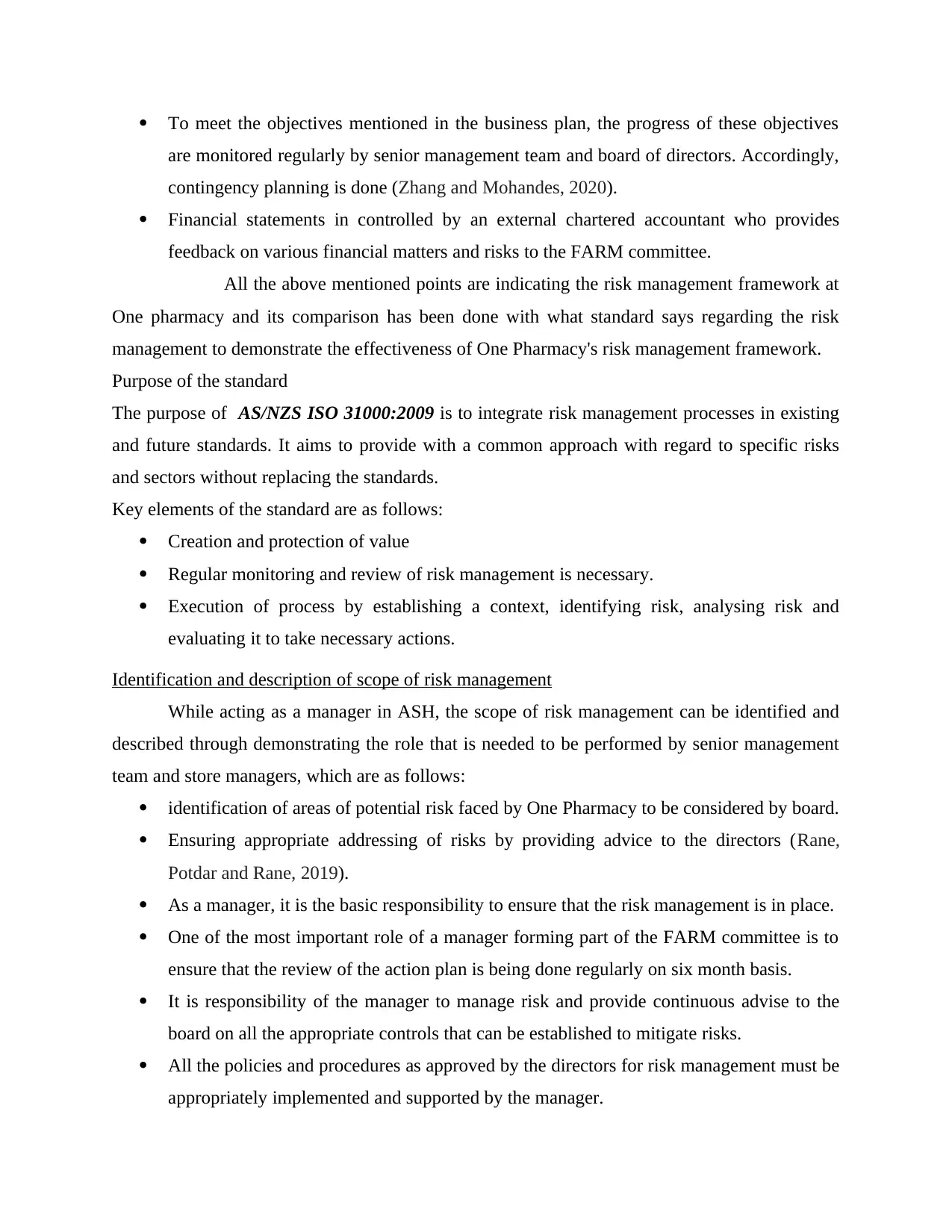
To meet the objectives mentioned in the business plan, the progress of these objectives
are monitored regularly by senior management team and board of directors. Accordingly,
contingency planning is done (Zhang and Mohandes, 2020).
Financial statements in controlled by an external chartered accountant who provides
feedback on various financial matters and risks to the FARM committee.
All the above mentioned points are indicating the risk management framework at
One pharmacy and its comparison has been done with what standard says regarding the risk
management to demonstrate the effectiveness of One Pharmacy's risk management framework.
Purpose of the standard
The purpose of AS/NZS ISO 31000:2009 is to integrate risk management processes in existing
and future standards. It aims to provide with a common approach with regard to specific risks
and sectors without replacing the standards.
Key elements of the standard are as follows:
Creation and protection of value
Regular monitoring and review of risk management is necessary.
Execution of process by establishing a context, identifying risk, analysing risk and
evaluating it to take necessary actions.
Identification and description of scope of risk management
While acting as a manager in ASH, the scope of risk management can be identified and
described through demonstrating the role that is needed to be performed by senior management
team and store managers, which are as follows:
identification of areas of potential risk faced by One Pharmacy to be considered by board.
Ensuring appropriate addressing of risks by providing advice to the directors (Rane,
Potdar and Rane, 2019).
As a manager, it is the basic responsibility to ensure that the risk management is in place.
One of the most important role of a manager forming part of the FARM committee is to
ensure that the review of the action plan is being done regularly on six month basis.
It is responsibility of the manager to manage risk and provide continuous advise to the
board on all the appropriate controls that can be established to mitigate risks.
All the policies and procedures as approved by the directors for risk management must be
appropriately implemented and supported by the manager.
are monitored regularly by senior management team and board of directors. Accordingly,
contingency planning is done (Zhang and Mohandes, 2020).
Financial statements in controlled by an external chartered accountant who provides
feedback on various financial matters and risks to the FARM committee.
All the above mentioned points are indicating the risk management framework at
One pharmacy and its comparison has been done with what standard says regarding the risk
management to demonstrate the effectiveness of One Pharmacy's risk management framework.
Purpose of the standard
The purpose of AS/NZS ISO 31000:2009 is to integrate risk management processes in existing
and future standards. It aims to provide with a common approach with regard to specific risks
and sectors without replacing the standards.
Key elements of the standard are as follows:
Creation and protection of value
Regular monitoring and review of risk management is necessary.
Execution of process by establishing a context, identifying risk, analysing risk and
evaluating it to take necessary actions.
Identification and description of scope of risk management
While acting as a manager in ASH, the scope of risk management can be identified and
described through demonstrating the role that is needed to be performed by senior management
team and store managers, which are as follows:
identification of areas of potential risk faced by One Pharmacy to be considered by board.
Ensuring appropriate addressing of risks by providing advice to the directors (Rane,
Potdar and Rane, 2019).
As a manager, it is the basic responsibility to ensure that the risk management is in place.
One of the most important role of a manager forming part of the FARM committee is to
ensure that the review of the action plan is being done regularly on six month basis.
It is responsibility of the manager to manage risk and provide continuous advise to the
board on all the appropriate controls that can be established to mitigate risks.
All the policies and procedures as approved by the directors for risk management must be
appropriately implemented and supported by the manager.
Paraphrase This Document
Need a fresh take? Get an instant paraphrase of this document with our AI Paraphraser
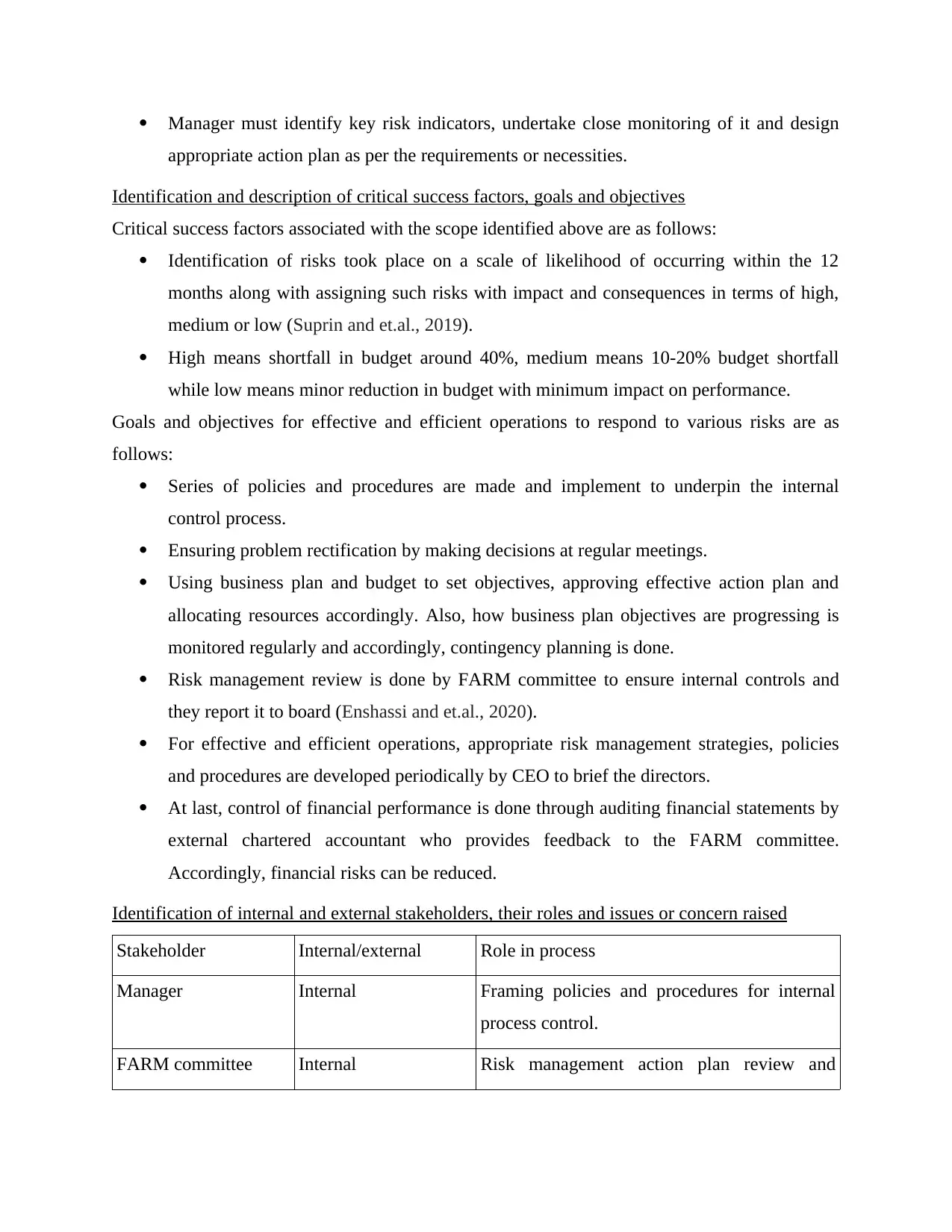
Manager must identify key risk indicators, undertake close monitoring of it and design
appropriate action plan as per the requirements or necessities.
Identification and description of critical success factors, goals and objectives
Critical success factors associated with the scope identified above are as follows:
Identification of risks took place on a scale of likelihood of occurring within the 12
months along with assigning such risks with impact and consequences in terms of high,
medium or low (Suprin and et.al., 2019).
High means shortfall in budget around 40%, medium means 10-20% budget shortfall
while low means minor reduction in budget with minimum impact on performance.
Goals and objectives for effective and efficient operations to respond to various risks are as
follows:
Series of policies and procedures are made and implement to underpin the internal
control process.
Ensuring problem rectification by making decisions at regular meetings.
Using business plan and budget to set objectives, approving effective action plan and
allocating resources accordingly. Also, how business plan objectives are progressing is
monitored regularly and accordingly, contingency planning is done.
Risk management review is done by FARM committee to ensure internal controls and
they report it to board (Enshassi and et.al., 2020).
For effective and efficient operations, appropriate risk management strategies, policies
and procedures are developed periodically by CEO to brief the directors.
At last, control of financial performance is done through auditing financial statements by
external chartered accountant who provides feedback to the FARM committee.
Accordingly, financial risks can be reduced.
Identification of internal and external stakeholders, their roles and issues or concern raised
Stakeholder Internal/external Role in process
Manager Internal Framing policies and procedures for internal
process control.
FARM committee Internal Risk management action plan review and
appropriate action plan as per the requirements or necessities.
Identification and description of critical success factors, goals and objectives
Critical success factors associated with the scope identified above are as follows:
Identification of risks took place on a scale of likelihood of occurring within the 12
months along with assigning such risks with impact and consequences in terms of high,
medium or low (Suprin and et.al., 2019).
High means shortfall in budget around 40%, medium means 10-20% budget shortfall
while low means minor reduction in budget with minimum impact on performance.
Goals and objectives for effective and efficient operations to respond to various risks are as
follows:
Series of policies and procedures are made and implement to underpin the internal
control process.
Ensuring problem rectification by making decisions at regular meetings.
Using business plan and budget to set objectives, approving effective action plan and
allocating resources accordingly. Also, how business plan objectives are progressing is
monitored regularly and accordingly, contingency planning is done.
Risk management review is done by FARM committee to ensure internal controls and
they report it to board (Enshassi and et.al., 2020).
For effective and efficient operations, appropriate risk management strategies, policies
and procedures are developed periodically by CEO to brief the directors.
At last, control of financial performance is done through auditing financial statements by
external chartered accountant who provides feedback to the FARM committee.
Accordingly, financial risks can be reduced.
Identification of internal and external stakeholders, their roles and issues or concern raised
Stakeholder Internal/external Role in process
Manager Internal Framing policies and procedures for internal
process control.
FARM committee Internal Risk management action plan review and
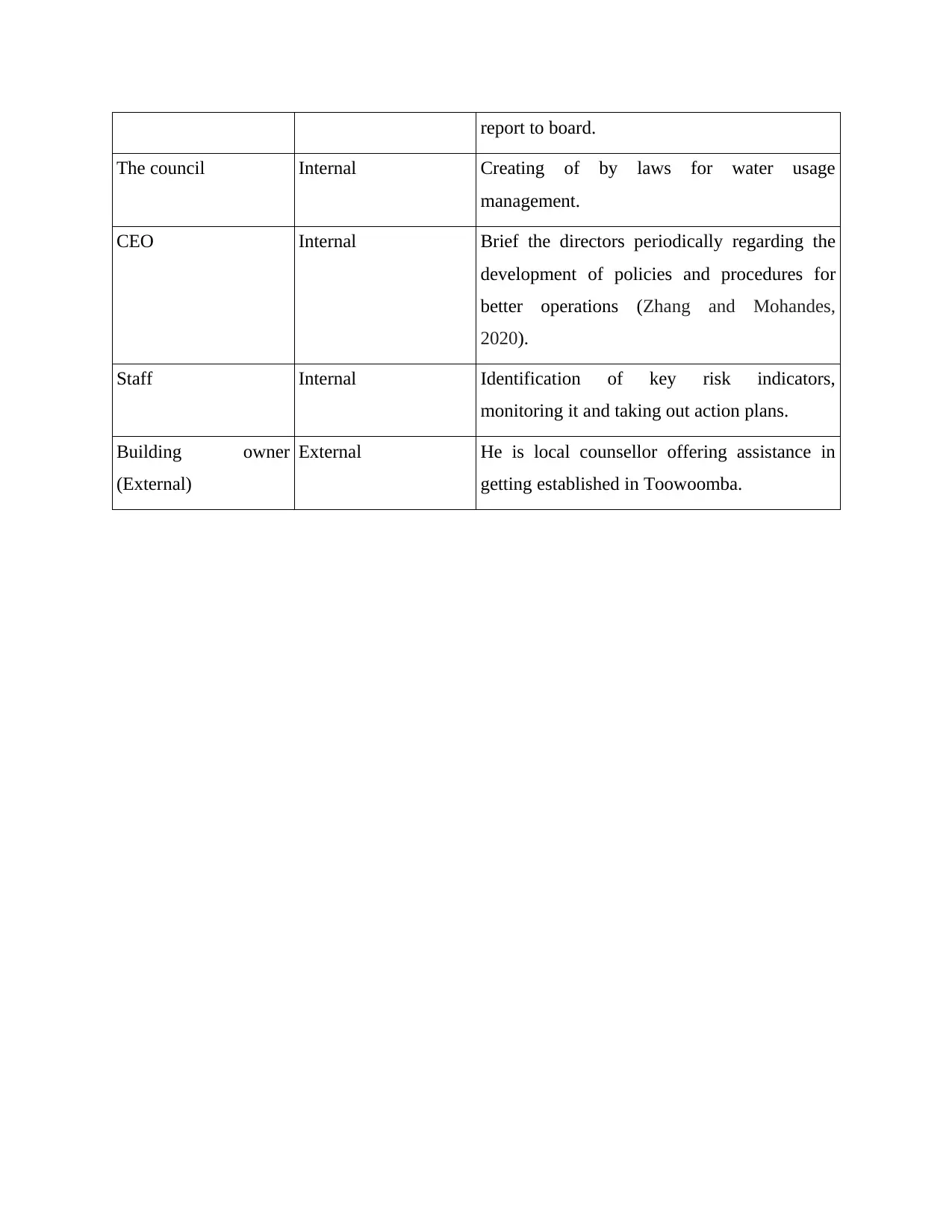
report to board.
The council Internal Creating of by laws for water usage
management.
CEO Internal Brief the directors periodically regarding the
development of policies and procedures for
better operations (Zhang and Mohandes,
2020).
Staff Internal Identification of key risk indicators,
monitoring it and taking out action plans.
Building owner
(External)
External He is local counsellor offering assistance in
getting established in Toowoomba.
The council Internal Creating of by laws for water usage
management.
CEO Internal Brief the directors periodically regarding the
development of policies and procedures for
better operations (Zhang and Mohandes,
2020).
Staff Internal Identification of key risk indicators,
monitoring it and taking out action plans.
Building owner
(External)
External He is local counsellor offering assistance in
getting established in Toowoomba.
⊘ This is a preview!⊘
Do you want full access?
Subscribe today to unlock all pages.

Trusted by 1+ million students worldwide
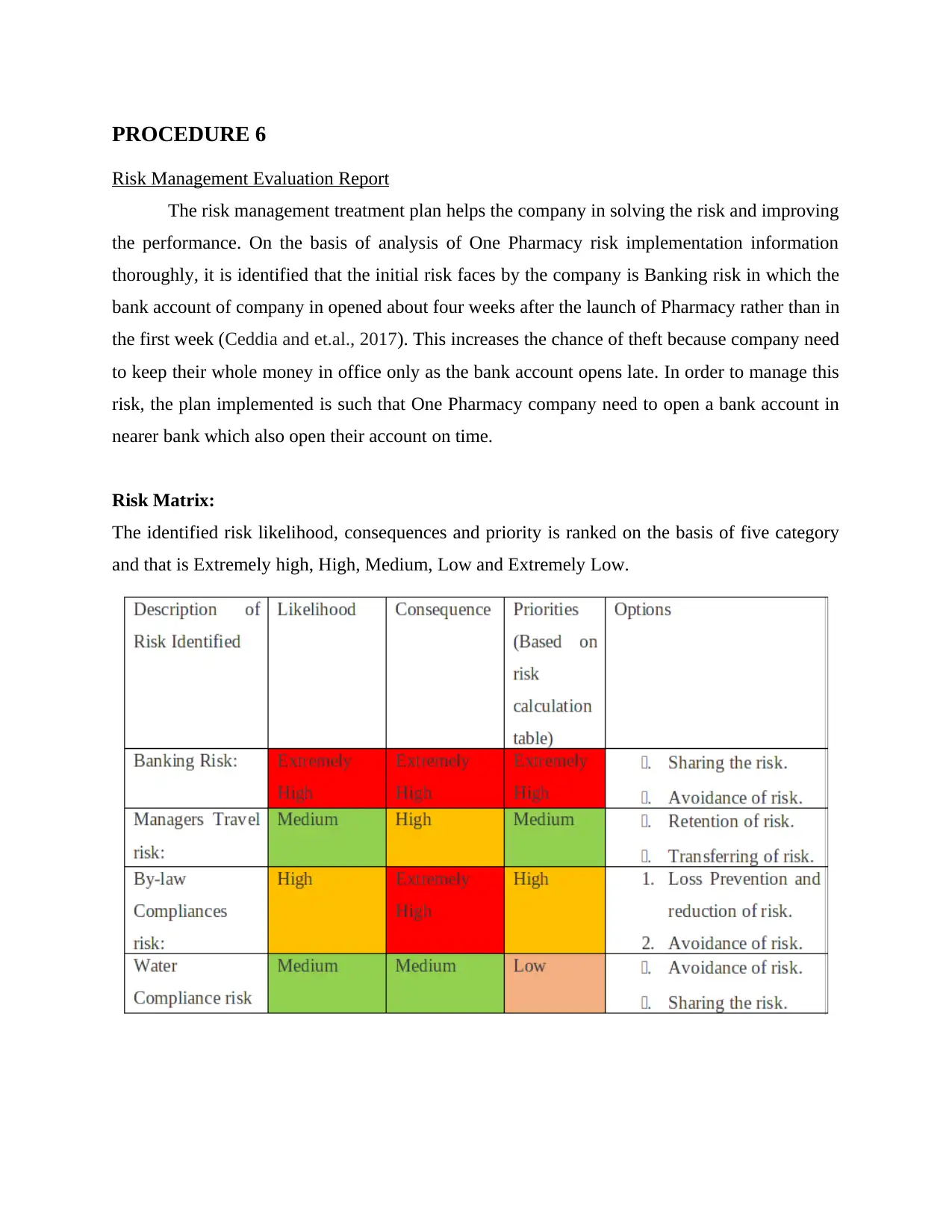
PROCEDURE 6
Risk Management Evaluation Report
The risk management treatment plan helps the company in solving the risk and improving
the performance. On the basis of analysis of One Pharmacy risk implementation information
thoroughly, it is identified that the initial risk faces by the company is Banking risk in which the
bank account of company in opened about four weeks after the launch of Pharmacy rather than in
the first week (Ceddia and et.al., 2017). This increases the chance of theft because company need
to keep their whole money in office only as the bank account opens late. In order to manage this
risk, the plan implemented is such that One Pharmacy company need to open a bank account in
nearer bank which also open their account on time.
Risk Matrix:
The identified risk likelihood, consequences and priority is ranked on the basis of five category
and that is Extremely high, High, Medium, Low and Extremely Low.
Risk Management Evaluation Report
The risk management treatment plan helps the company in solving the risk and improving
the performance. On the basis of analysis of One Pharmacy risk implementation information
thoroughly, it is identified that the initial risk faces by the company is Banking risk in which the
bank account of company in opened about four weeks after the launch of Pharmacy rather than in
the first week (Ceddia and et.al., 2017). This increases the chance of theft because company need
to keep their whole money in office only as the bank account opens late. In order to manage this
risk, the plan implemented is such that One Pharmacy company need to open a bank account in
nearer bank which also open their account on time.
Risk Matrix:
The identified risk likelihood, consequences and priority is ranked on the basis of five category
and that is Extremely high, High, Medium, Low and Extremely Low.
Paraphrase This Document
Need a fresh take? Get an instant paraphrase of this document with our AI Paraphraser
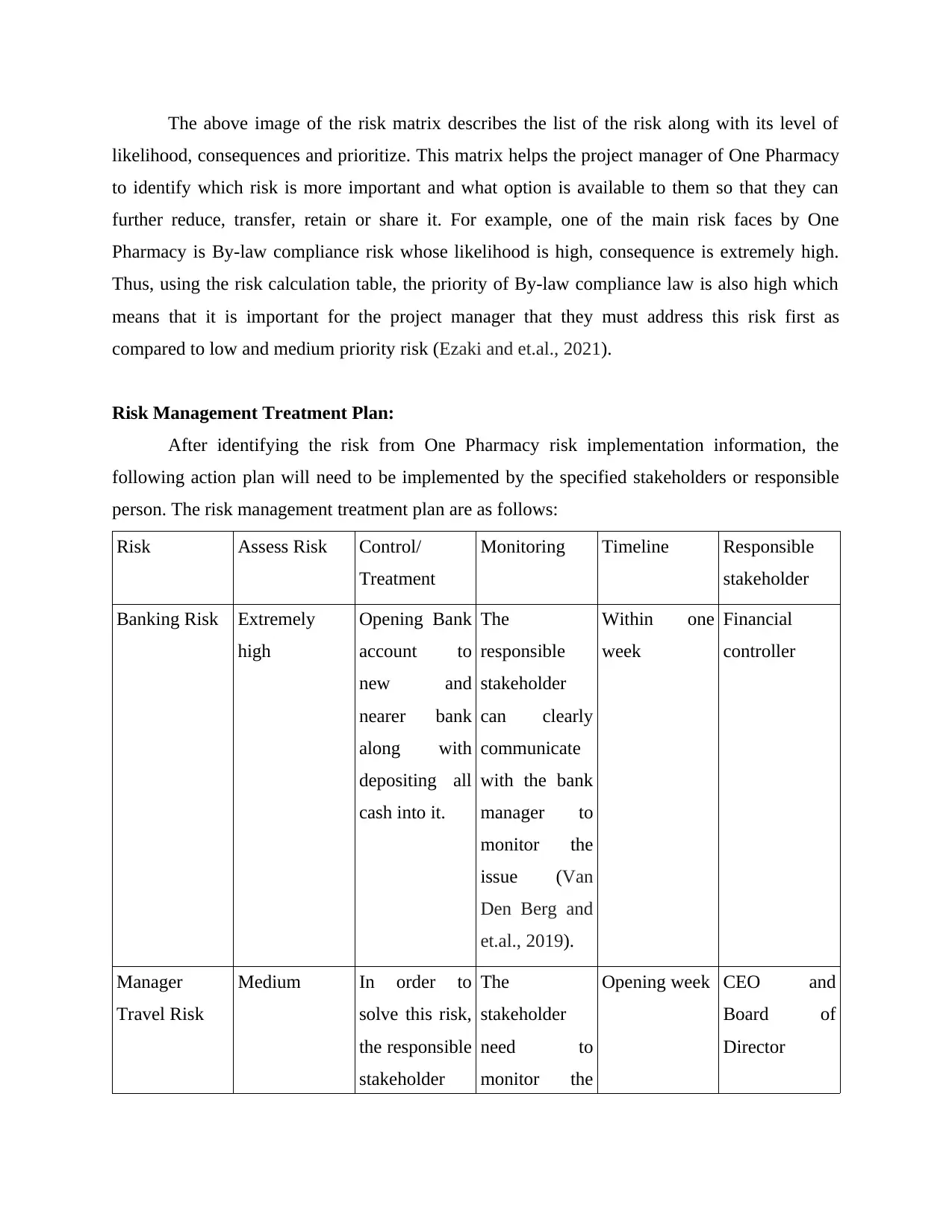
The above image of the risk matrix describes the list of the risk along with its level of
likelihood, consequences and prioritize. This matrix helps the project manager of One Pharmacy
to identify which risk is more important and what option is available to them so that they can
further reduce, transfer, retain or share it. For example, one of the main risk faces by One
Pharmacy is By-law compliance risk whose likelihood is high, consequence is extremely high.
Thus, using the risk calculation table, the priority of By-law compliance law is also high which
means that it is important for the project manager that they must address this risk first as
compared to low and medium priority risk (Ezaki and et.al., 2021).
Risk Management Treatment Plan:
After identifying the risk from One Pharmacy risk implementation information, the
following action plan will need to be implemented by the specified stakeholders or responsible
person. The risk management treatment plan are as follows:
Risk Assess Risk Control/
Treatment
Monitoring Timeline Responsible
stakeholder
Banking Risk Extremely
high
Opening Bank
account to
new and
nearer bank
along with
depositing all
cash into it.
The
responsible
stakeholder
can clearly
communicate
with the bank
manager to
monitor the
issue (Van
Den Berg and
et.al., 2019).
Within one
week
Financial
controller
Manager
Travel Risk
Medium In order to
solve this risk,
the responsible
stakeholder
The
stakeholder
need to
monitor the
Opening week CEO and
Board of
Director
likelihood, consequences and prioritize. This matrix helps the project manager of One Pharmacy
to identify which risk is more important and what option is available to them so that they can
further reduce, transfer, retain or share it. For example, one of the main risk faces by One
Pharmacy is By-law compliance risk whose likelihood is high, consequence is extremely high.
Thus, using the risk calculation table, the priority of By-law compliance law is also high which
means that it is important for the project manager that they must address this risk first as
compared to low and medium priority risk (Ezaki and et.al., 2021).
Risk Management Treatment Plan:
After identifying the risk from One Pharmacy risk implementation information, the
following action plan will need to be implemented by the specified stakeholders or responsible
person. The risk management treatment plan are as follows:
Risk Assess Risk Control/
Treatment
Monitoring Timeline Responsible
stakeholder
Banking Risk Extremely
high
Opening Bank
account to
new and
nearer bank
along with
depositing all
cash into it.
The
responsible
stakeholder
can clearly
communicate
with the bank
manager to
monitor the
issue (Van
Den Berg and
et.al., 2019).
Within one
week
Financial
controller
Manager
Travel Risk
Medium In order to
solve this risk,
the responsible
stakeholder
The
stakeholder
need to
monitor the
Opening week CEO and
Board of
Director
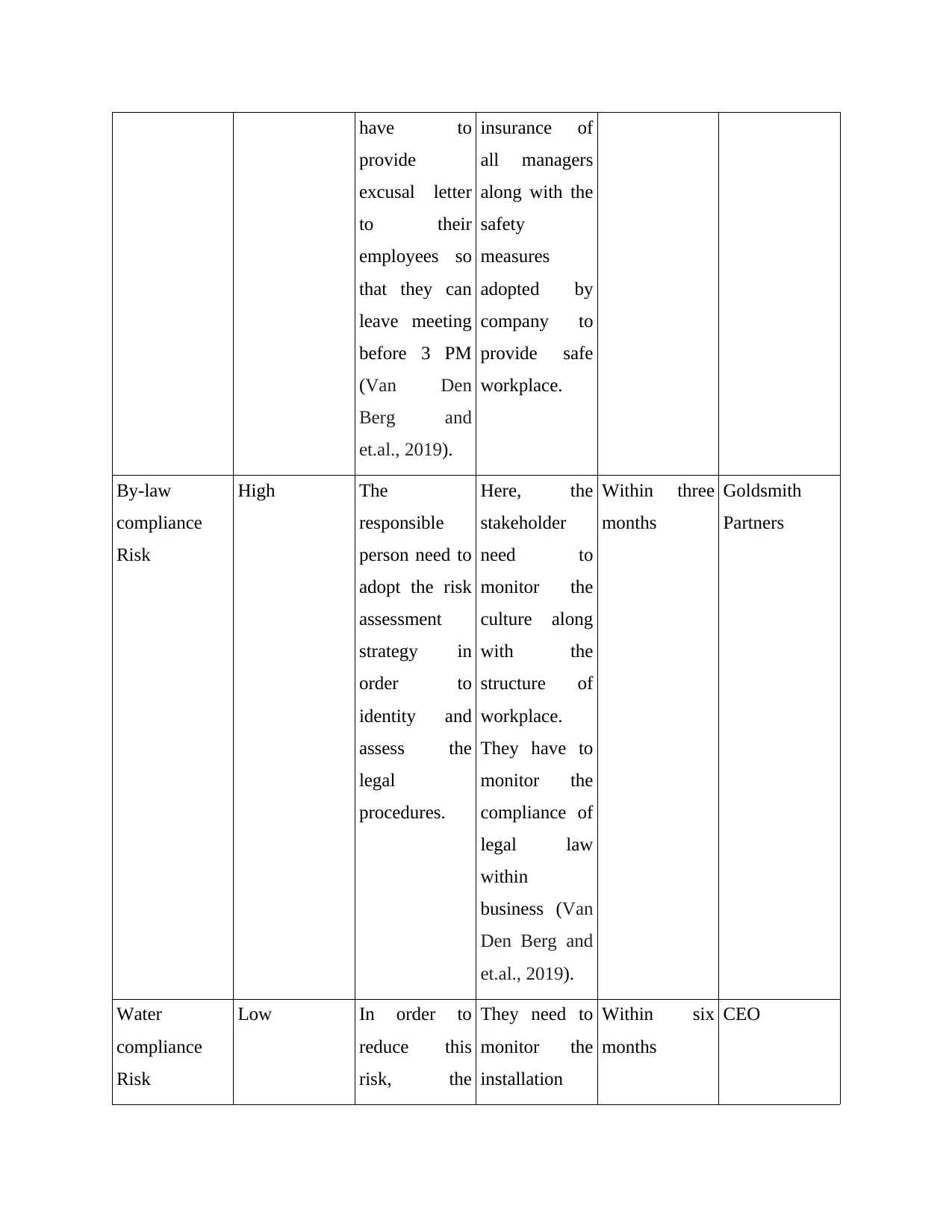
have to
provide
excusal letter
to their
employees so
that they can
leave meeting
before 3 PM
(Van Den
Berg and
et.al., 2019).
insurance of
all managers
along with the
safety
measures
adopted by
company to
provide safe
workplace.
By-law
compliance
Risk
High The
responsible
person need to
adopt the risk
assessment
strategy in
order to
identity and
assess the
legal
procedures.
Here, the
stakeholder
need to
monitor the
culture along
with the
structure of
workplace.
They have to
monitor the
compliance of
legal law
within
business (Van
Den Berg and
et.al., 2019).
Within three
months
Goldsmith
Partners
Water
compliance
Risk
Low In order to
reduce this
risk, the
They need to
monitor the
installation
Within six
months
CEO
provide
excusal letter
to their
employees so
that they can
leave meeting
before 3 PM
(Van Den
Berg and
et.al., 2019).
insurance of
all managers
along with the
safety
measures
adopted by
company to
provide safe
workplace.
By-law
compliance
Risk
High The
responsible
person need to
adopt the risk
assessment
strategy in
order to
identity and
assess the
legal
procedures.
Here, the
stakeholder
need to
monitor the
culture along
with the
structure of
workplace.
They have to
monitor the
compliance of
legal law
within
business (Van
Den Berg and
et.al., 2019).
Within three
months
Goldsmith
Partners
Water
compliance
Risk
Low In order to
reduce this
risk, the
They need to
monitor the
installation
Within six
months
CEO
⊘ This is a preview!⊘
Do you want full access?
Subscribe today to unlock all pages.

Trusted by 1+ million students worldwide
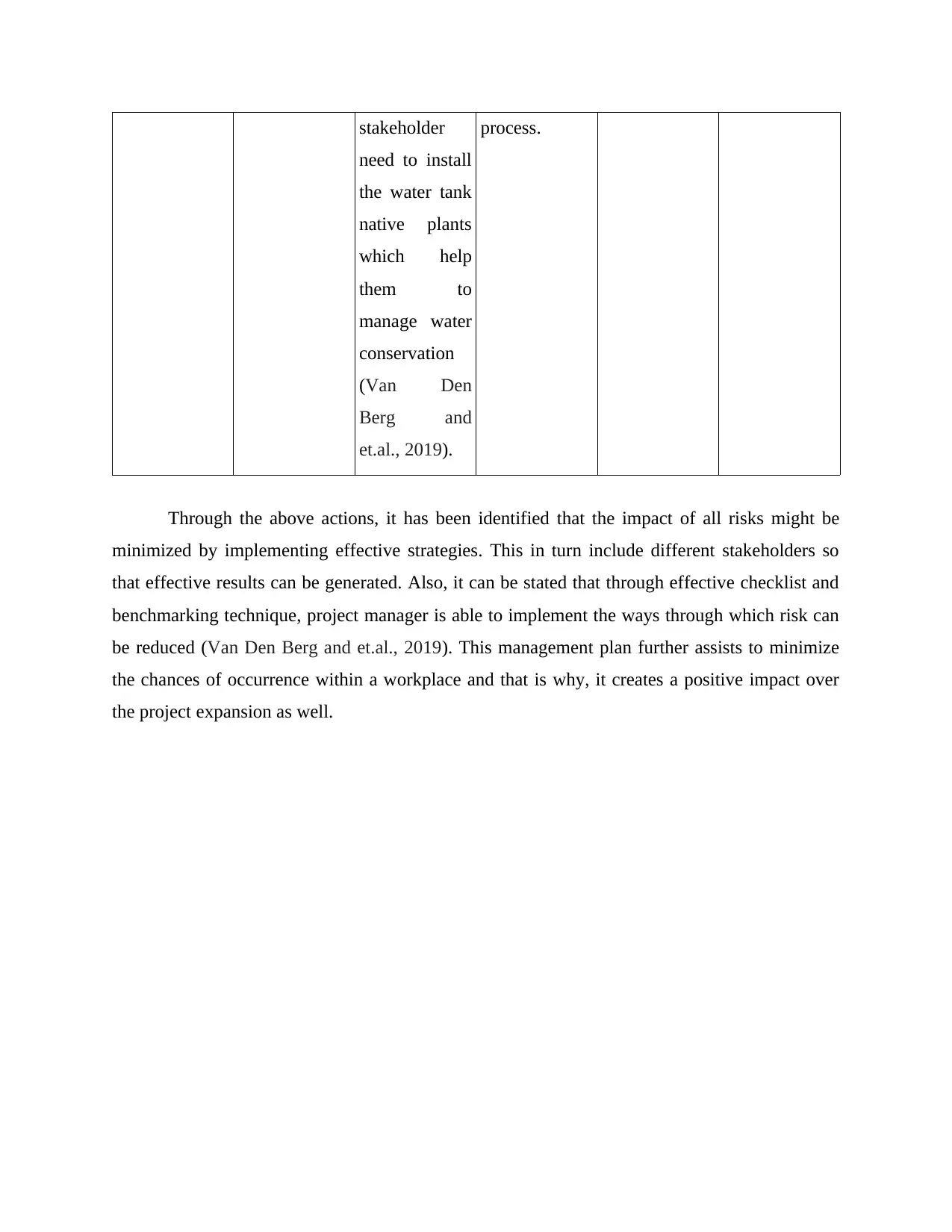
stakeholder
need to install
the water tank
native plants
which help
them to
manage water
conservation
(Van Den
Berg and
et.al., 2019).
process.
Through the above actions, it has been identified that the impact of all risks might be
minimized by implementing effective strategies. This in turn include different stakeholders so
that effective results can be generated. Also, it can be stated that through effective checklist and
benchmarking technique, project manager is able to implement the ways through which risk can
be reduced (Van Den Berg and et.al., 2019). This management plan further assists to minimize
the chances of occurrence within a workplace and that is why, it creates a positive impact over
the project expansion as well.
need to install
the water tank
native plants
which help
them to
manage water
conservation
(Van Den
Berg and
et.al., 2019).
process.
Through the above actions, it has been identified that the impact of all risks might be
minimized by implementing effective strategies. This in turn include different stakeholders so
that effective results can be generated. Also, it can be stated that through effective checklist and
benchmarking technique, project manager is able to implement the ways through which risk can
be reduced (Van Den Berg and et.al., 2019). This management plan further assists to minimize
the chances of occurrence within a workplace and that is why, it creates a positive impact over
the project expansion as well.
Paraphrase This Document
Need a fresh take? Get an instant paraphrase of this document with our AI Paraphraser
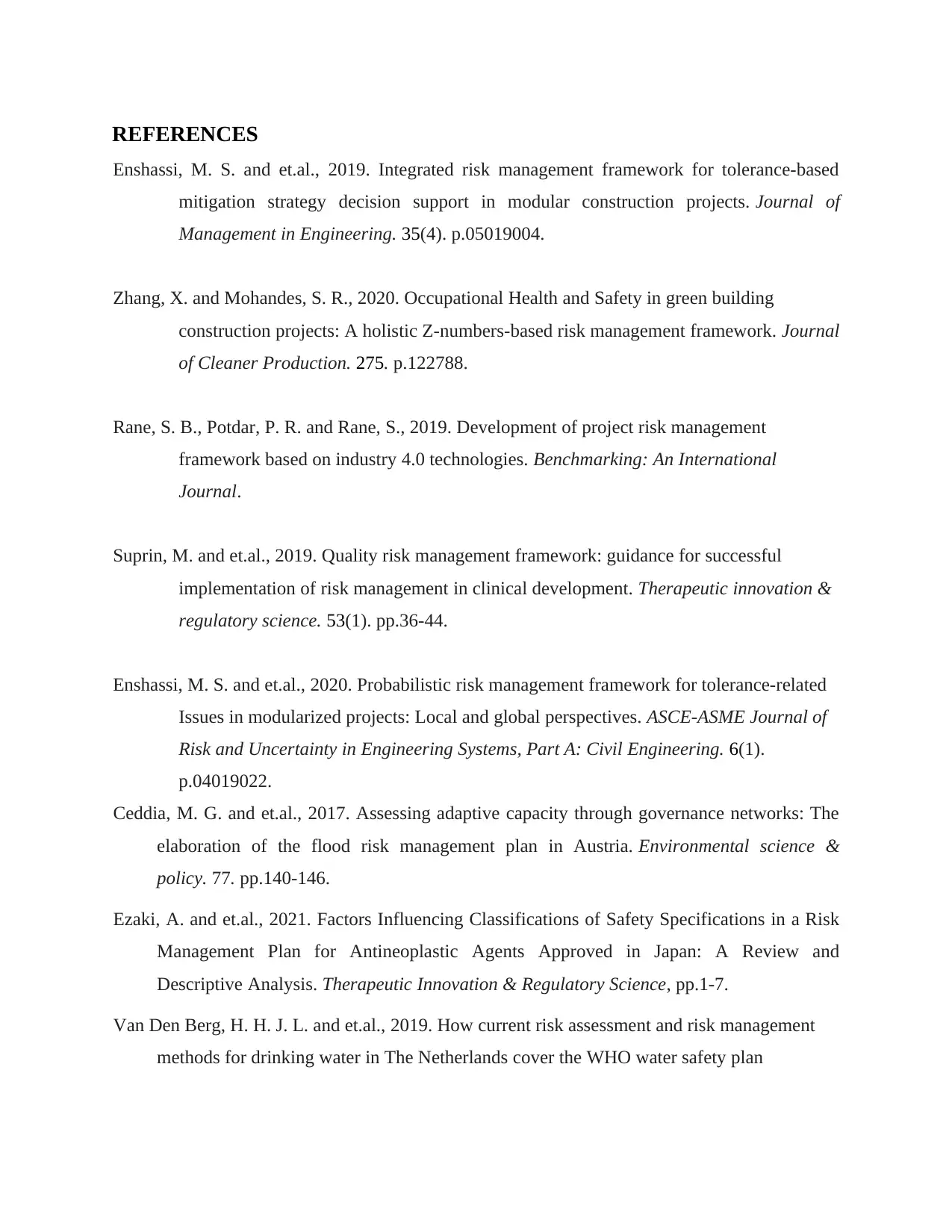
REFERENCES
Enshassi, M. S. and et.al., 2019. Integrated risk management framework for tolerance-based
mitigation strategy decision support in modular construction projects. Journal of
Management in Engineering. 35(4). p.05019004.
Zhang, X. and Mohandes, S. R., 2020. Occupational Health and Safety in green building
construction projects: A holistic Z-numbers-based risk management framework. Journal
of Cleaner Production. 275. p.122788.
Rane, S. B., Potdar, P. R. and Rane, S., 2019. Development of project risk management
framework based on industry 4.0 technologies. Benchmarking: An International
Journal.
Suprin, M. and et.al., 2019. Quality risk management framework: guidance for successful
implementation of risk management in clinical development. Therapeutic innovation &
regulatory science. 53(1). pp.36-44.
Enshassi, M. S. and et.al., 2020. Probabilistic risk management framework for tolerance-related
Issues in modularized projects: Local and global perspectives. ASCE-ASME Journal of
Risk and Uncertainty in Engineering Systems, Part A: Civil Engineering. 6(1).
p.04019022.
Ceddia, M. G. and et.al., 2017. Assessing adaptive capacity through governance networks: The
elaboration of the flood risk management plan in Austria. Environmental science &
policy. 77. pp.140-146.
Ezaki, A. and et.al., 2021. Factors Influencing Classifications of Safety Specifications in a Risk
Management Plan for Antineoplastic Agents Approved in Japan: A Review and
Descriptive Analysis. Therapeutic Innovation & Regulatory Science, pp.1-7.
Van Den Berg, H. H. J. L. and et.al., 2019. How current risk assessment and risk management
methods for drinking water in The Netherlands cover the WHO water safety plan
Enshassi, M. S. and et.al., 2019. Integrated risk management framework for tolerance-based
mitigation strategy decision support in modular construction projects. Journal of
Management in Engineering. 35(4). p.05019004.
Zhang, X. and Mohandes, S. R., 2020. Occupational Health and Safety in green building
construction projects: A holistic Z-numbers-based risk management framework. Journal
of Cleaner Production. 275. p.122788.
Rane, S. B., Potdar, P. R. and Rane, S., 2019. Development of project risk management
framework based on industry 4.0 technologies. Benchmarking: An International
Journal.
Suprin, M. and et.al., 2019. Quality risk management framework: guidance for successful
implementation of risk management in clinical development. Therapeutic innovation &
regulatory science. 53(1). pp.36-44.
Enshassi, M. S. and et.al., 2020. Probabilistic risk management framework for tolerance-related
Issues in modularized projects: Local and global perspectives. ASCE-ASME Journal of
Risk and Uncertainty in Engineering Systems, Part A: Civil Engineering. 6(1).
p.04019022.
Ceddia, M. G. and et.al., 2017. Assessing adaptive capacity through governance networks: The
elaboration of the flood risk management plan in Austria. Environmental science &
policy. 77. pp.140-146.
Ezaki, A. and et.al., 2021. Factors Influencing Classifications of Safety Specifications in a Risk
Management Plan for Antineoplastic Agents Approved in Japan: A Review and
Descriptive Analysis. Therapeutic Innovation & Regulatory Science, pp.1-7.
Van Den Berg, H. H. J. L. and et.al., 2019. How current risk assessment and risk management
methods for drinking water in The Netherlands cover the WHO water safety plan
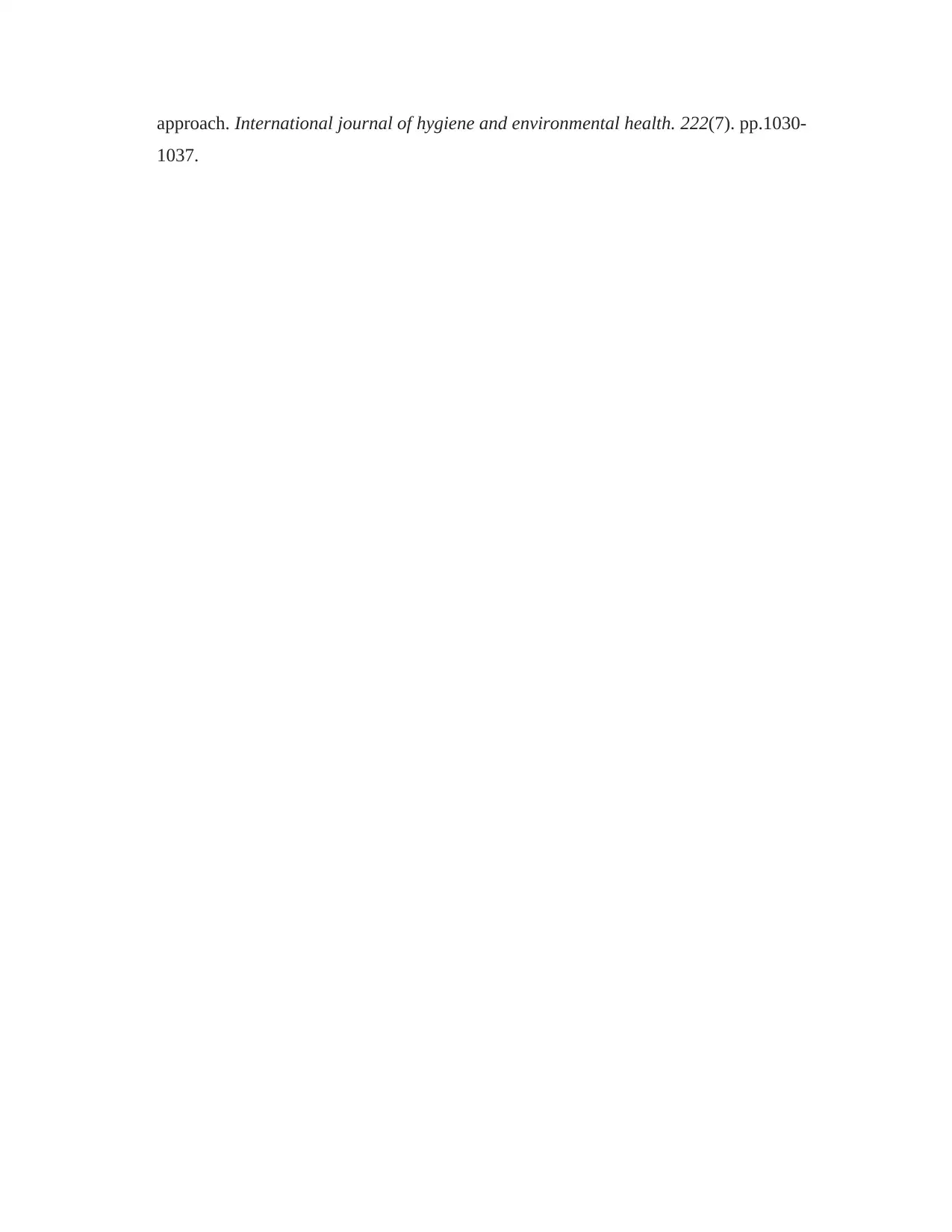
approach. International journal of hygiene and environmental health. 222(7). pp.1030-
1037.
1037.
⊘ This is a preview!⊘
Do you want full access?
Subscribe today to unlock all pages.

Trusted by 1+ million students worldwide
1 out of 12
Related Documents
Your All-in-One AI-Powered Toolkit for Academic Success.
+13062052269
info@desklib.com
Available 24*7 on WhatsApp / Email
![[object Object]](/_next/static/media/star-bottom.7253800d.svg)
Unlock your academic potential
© 2024 | Zucol Services PVT LTD | All rights reserved.




